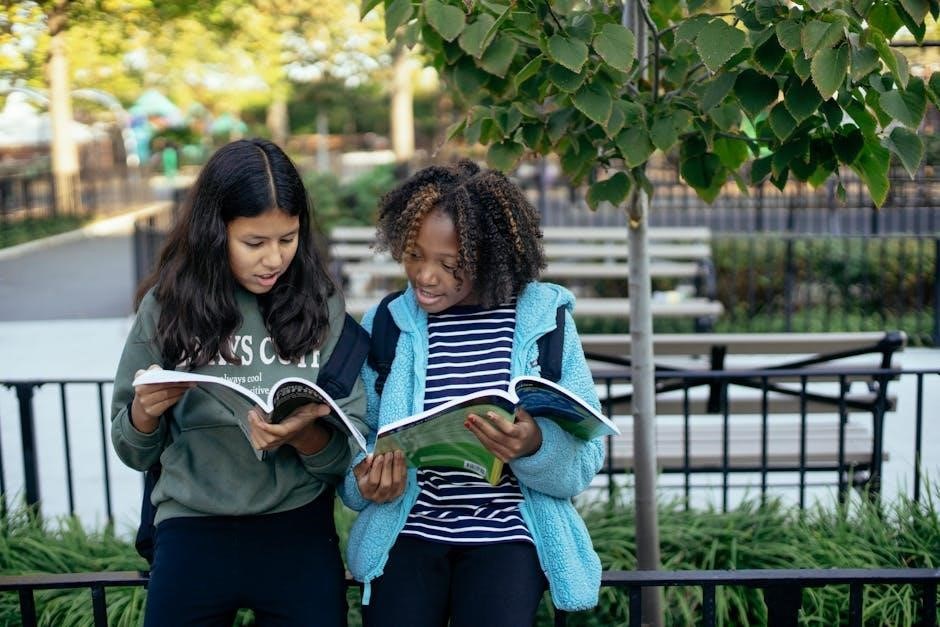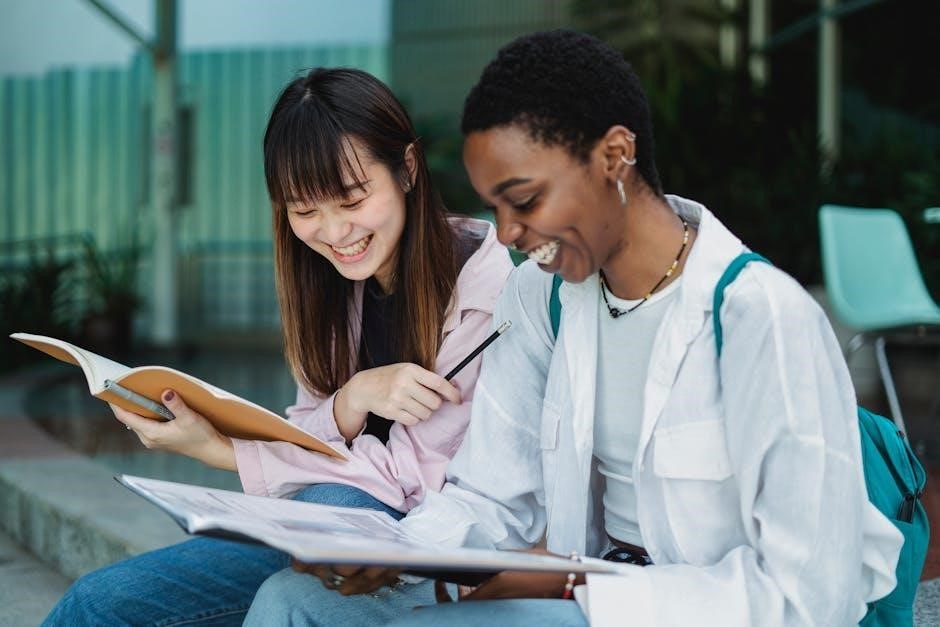How to Talk to Anyone by Leil Lowndes offers 92 practical techniques to master conversations and build relationships, helping readers communicate confidently and authentically in any setting.
Overview of the Book
How to Talk to Anyone by Leil Lowndes is a comprehensive guide offering 92 practical techniques to improve conversation skills and build meaningful relationships. The book emphasizes non-verbal cues, body language, and the power of listening to connect with others. It provides actionable tips for initiating and maintaining engaging conversations, from the initial greeting to handling awkward situations. Whether you’re looking to enhance professional interactions or social connections, this self-help guide equips readers with tools to communicate confidently and authentically. Available in multiple formats, including PDF, it remains a go-to resource for mastering interpersonal communication and making a lasting impression.
Importance of Effective Communication
Effective communication is the cornerstone of meaningful relationships and professional success. It fosters understanding, builds trust, and helps navigate social and workplace interactions seamlessly. By mastering communication, individuals can express ideas clearly, resolve conflicts, and connect with others on a deeper level. How to Talk to Anyone emphasizes the significance of verbal and non-verbal cues, highlighting how these skills can transform interactions. Whether personal or professional, strong communication enhances confidence, collaboration, and empathy, making it an essential skill for everyone. The book provides practical tools to overcome barriers, ensuring conversations are engaging and impactful, ultimately leading to stronger, more fulfilling connections.
Structure of the Book
How to Talk to Anyone is structured into six comprehensive parts, each focusing on specific skills to enhance communication. Part One explores non-verbal communication, while Part Two provides strategies for starting and maintaining conversations. The book progresses to advanced techniques, such as finding common ground and handling awkward situations. Part Four emphasizes showing genuine interest, and Part Five focuses on credibility and confidence. The final section, Part Six, delves into building rapport through mirroring and empathy. Each chapter offers practical advice, ensuring readers can apply the techniques in real-life scenarios. With a total of 92 tricks, the book is designed to help anyone master the art of conversation, regardless of their current skill level.

Part One: How to Intrigue Everyone Without Saying a Word
This section focuses on making a strong first impression through non-verbal communication, such as body language and presence, to captivate others instantly and silently.
The 10-Second Rule
The 10-Second Rule emphasizes the importance of making a strong first impression within the first ten seconds of meeting someone. This principle, outlined in How to Talk to Anyone, highlights how initial judgments are formed quickly. By maintaining positive body language and confidence, individuals can create an immediate and lasting impact. The rule underscores the significance of non-verbal cues, such as posture and eye contact, in conveying self-assurance and approachability. Mastering this rule helps individuals captivate others from the very start, setting the tone for successful interactions and meaningful connections. Effective use of this technique can significantly enhance one’s social and professional opportunities.
Using Positive Body Language
Positive body language is a cornerstone of effective communication, enabling individuals to convey confidence and approachability. Key elements include maintaining good posture, making direct eye contact, and smiling genuinely. Open gestures, such as uncrossing arms, signal receptiveness and engagement. Nodding and leaning slightly forward during conversations demonstrates active listening and interest. These non-verbal cues create a welcoming atmosphere, encouraging others to feel at ease. By aligning body language with verbal messages, individuals can build trust and rapport effortlessly. Consistency in positive body language fosters a perception of authenticity and friendliness, making social interactions more enjoyable and productive. It’s a powerful tool for connecting with others instantly.
Limit the Fidget
Fidgeting can undermine confidence and distract others, making it essential to manage nervous movements. Simple techniques like keeping hands visible and still, avoiding foot tapping, and minimizing object manipulation can reduce fidgeting. Using pauses during speech allows for natural breaks without appearing restless. Practicing mindfulness or deep breathing helps maintain calm. Redirecting nervous energy into purposeful gestures, like using hand movements to emphasize points, keeps communication focused. By controlling fidgeting, individuals project confidence and maintain the listener’s attention. Small adjustments in behavior can significantly enhance perceived self-assurance and improve overall communication effectiveness. Awareness is the first step to mastering this skill.

Part Two: How to Know What to Say After “Hello”
Mastering the art of conversation beyond the initial greeting involves active listening, asking open-ended questions, and using the environment to find common topics. These strategies help establish rapport and keep the dialogue engaging, ensuring meaningful interactions that go beyond small talk.
The Power of Listening
Effective communication begins with the ability to listen actively and genuinely. By focusing on the speaker, nodding, and maintaining eye contact, you create a safe space for them to express themselves; Reflecting back what you hear, through phrases like “What I hear you saying is…” or “It sounds like…,” ensures understanding and shows empathy. Avoid interrupting or planning your next response while the other person is speaking. Instead, wait for natural pauses to contribute. This approach fosters trust, encourages openness, and helps you gather insights to guide the conversation naturally. True listening is the foundation of meaningful connections and engaging dialogue.
Encouraging Responses
Encouraging responses involves creating an environment where the other person feels comfortable sharing their thoughts. Using open-ended questions that begin with “what,” “how,” or “why” prompts detailed answers. Nodding, smiling, and maintaining eye contact signal interest and invitation to continue. Phrases like “That’s fascinating” or “Tell me more” act as verbal cues to deepen the conversation. Avoid giving unsolicited advice; instead, ask reflective questions like, “How did that make you feel?” This approach makes the speaker feel valued and understood, fostering a natural flow of dialogue. By being present and engaged, you encourage openness and meaningful exchange.
Asking Open-Ended Questions
Asking open-ended questions is a powerful way to spark meaningful conversations and keep them flowing. These questions cannot be answered with a simple “yes” or “no” and encourage the other person to share their thoughts and feelings. For example, questions like, “What inspired you to pursue that?” or “How did you feel about that experience?” invite detailed responses. Open-ended questions prevent conversations from stalling and show genuine interest in the other person. By framing your inquiries this way, you create opportunities for deeper dialogue and connection. This approach ensures the conversation remains engaging and mutually rewarding for both parties involved.

Part Three: How to Talk About Anything with Anyone
Master the art of connecting with anyone by finding common ground, navigating diverse topics, and handling awkward moments with ease and confidence.

Finding Common Ground
Finding common ground is a cornerstone of effective communication, enabling connections with people from diverse backgrounds. It involves identifying shared interests, experiences, or values to create rapport. Start by actively listening to others, asking open-ended questions, and observing nonverbal cues. This helps uncover mutual topics like hobbies, work, or passions. Once common ground is identified, use it as a conversation starter or anchor point. Authenticity is key—people can sense insincerity. By showing genuine interest and empathy, you build trust and make interactions more engaging. This technique fosters meaningful conversations, making even strangers feel at ease. It’s a powerful way to bridge gaps and establish connection quickly.
Mastering the Art of Small Talk
Mastering small talk is essential for building connections and setting the tone for deeper conversations. It involves being prepared with light, universal topics like hobbies, movies, or current events. Start with open-ended questions to encourage engagement, and avoid controversial subjects. Focus on listening actively and showing genuine interest in the other person. Use positive body language, such as maintaining eye contact and smiling, to create a welcoming atmosphere. Keep the conversation balanced by sharing a little about yourself while asking questions. Transition smoothly by linking topics to deeper discussions. Remember, small talk is about being approachable, relatable, and authentic, not about being perfect. It’s a skill that, with practice, becomes second nature and opens doors to meaningful interactions.
Handling Awkward Situations
Awkward situations can arise in any conversation, but how you handle them determines the outcome. Stay calm and acknowledge the moment with a light-hearted comment to ease tension. Redirect the conversation to a safer topic by asking a question or making a relatable observation. Use humor sparingly to diffuse awkwardness, but avoid forcing it. Practice active listening and show empathy to shift focus back to the other person. Maintain positive body language, such as uncrossing your arms or smiling, to signal openness. Prepare mentally for unexpected moments by staying present and adaptable. Remember, awkwardness is temporary, and grace under pressure strengthens connections.

Part Four: How to Let Anyone Know You’re Interested
Showing genuine interest involves active engagement and subtle cues. Use eye contact, nods, and mirroring body language to convey attention. Ask thoughtful questions and listen intently.

Showing Genuine Interest
Showing genuine interest is about being present and engaged in conversations. It starts with maintaining eye contact and using open, approachable body language. Smile and lean slightly forward to signal attentiveness. Avoid distractions like your phone or surroundings. Ask open-ended questions that encourage the other person to share more about themselves. Listen actively by nodding and summarizing what they say. Show enthusiasm through verbal cues like “That’s fascinating!” or “I can see why you’d feel that way.” Authentic curiosity builds trust and makes conversations more meaningful. People are more likely to open up when they feel valued and understood.
Using Mirroring Techniques
Mirroring techniques involve subtly reflecting the other person’s speech patterns, body language, or tone to create a sense of rapport. Repeat key phrases they use or adopt a similar pace and pitch in your voice. For example, if they say, “I love spending time outdoors,” you might respond, “Spending time outdoors sounds amazing.” This builds trust and makes the conversation feel more natural. Mirror their gestures or posture slightly, but avoid overdoing it. The goal is to create a subconscious connection, making the other person feel heard and understood. Done authentically, mirroring can deepen the conversation and keep it flowing smoothly.
Subtle Signals of Engagement
Subtle signals of engagement, such as nodding, maintaining eye contact, or tilting your head, convey interest without being overly expressive. These non-verbal cues show the other person they are being heard and valued. Smiling gently or leaning forward slightly can also signal active listening. Avoid crossing your arms or looking away, as these may suggest disinterest. Instead, use open and relaxed body language to create a welcoming atmosphere; These subtle signals help build trust and keep the conversation flowing naturally. By being attentive and present, you encourage the other person to open up and feel comfortable sharing their thoughts.

Part Five: How to Come Across as 100% Credible
Being credible involves projecting confidence and trustworthiness. Authenticity, consistency, and clarity in communication are essential. Prepare thoroughly and embrace your unique voice to build trust naturally.
Being Authentic in Conversations
Authenticity is the foundation of credible communication. People trust those who are genuine and true to themselves. Avoid pretending to be someone you’re not, as it can undermine your credibility. Instead, embrace your unique perspective and experiences. Being honest and transparent fosters deeper connections. Authenticity also means admitting when you don’t know something, which shows humility and builds trust. Sharing personal stories or vulnerabilities can make you more relatable. Remember, authenticity isn’t about perfection; it’s about being real. When you speak from the heart, others are more likely to believe in you and value your words.
Managing Nervousness
Nervousness can hinder effective communication, but it can be managed with the right techniques. Deep breathing is a powerful tool to calm your nerves before speaking. Take slow, deep breaths to reduce heart rate and steady your voice. Positive self-talk can also help; remind yourself of your strengths and preparation. Focus on the conversation’s purpose rather than your anxiety. Reframe nervousness as excitement to channel energy positively. Practice relaxation exercises, like rolling your shoulders or unclenching your fists, to release tension. Remember, others are more focused on the message than your nervousness. With practice, confidence grows, and nervousness fades.
Confidence Through Preparation
Confidence in conversations often stems from thorough preparation. Researching common topics or practicing responses can help you feel more secure. Organize your thoughts beforehand to avoid feeling overwhelmed. Visualize successful interactions to build mental confidence; Preparation reduces anxiety and ensures you have something valuable to contribute. It also helps you stay focused and composed during the conversation. While preparation is key, avoid scripting responses, as it can feel unnatural. Instead, focus on understanding the subject matter deeply. This approach fosters genuine confidence, making you more engaging and credible. Preparation not only boosts your self-assurance but also enhances your ability to connect meaningfully with others.

Part Six: How to Build Rapport
Building rapport involves creating emotional connections through empathy, shared experiences, and mutual understanding. Techniques like mirroring and positive reinforcement foster trust and deepen relationships effectively always.
Mirroring Speech Patterns
Mirroring speech patterns is a powerful technique to build rapport by subtly aligning your communication style with the other person. This involves adopting similar tone, pace, and language to create a sense of connection. For example, if they speak quickly, you respond with a similar rhythm. Mirroring also extends to vocabulary and phrasing, making the conversation feel more natural. However, it’s crucial to mirror authentically without overdoing it, as insincerity can undermine trust. Start with small adjustments, like nodding or using similar expressions, to foster a harmonious dialogue. This approach helps people feel understood and valued, strengthening your relationship effortlessly over time.
Using Positive Reinforcement
Positive reinforcement is a cornerstone of effective communication, as it encourages others to feel valued and heard. By using affirming phrases like “That’s a great point” or “I appreciate your insight,” you create a supportive environment. Smiling, nodding, and maintaining eye contact also reinforce engagement; This approach not only boosts the other person’s confidence but also fosters a sense of connection. Consistent positive reinforcement makes conversations more enjoyable and encourages openness. It’s essential to be genuine, as insincere praise can undermine trust. By incorporating these techniques, you can naturally guide conversations toward deeper understanding and mutual respect, fostering meaningful relationships over time.
Showing Empathy
Showing empathy is crucial for building trust and understanding in conversations. It involves actively listening to others, acknowledging their emotions, and validating their experiences. Empathy creates a safe space for open dialogue, allowing people to feel heard and respected. Techniques include maintaining eye contact, nodding to show engagement, and reflecting back what you’ve heard. Phrases like “I can see why you’d feel that way” or “That sounds challenging” demonstrate understanding. Empathy isn’t about agreeing but about connecting on a human level. By showing genuine care, you foster deeper connections and encourage others to open up, making conversations more meaningful and productive.
Mastering communication skills transforms relationships and opportunities. By applying these strategies, you’ll connect deeply, build trust, and communicate confidently. Practice consistently to refine your approach and succeed.
The book “How to Talk to Anyone” offers practical strategies to enhance communication skills. Key takeaways include the importance of non-verbal cues, active listening, and asking open-ended questions. Mastering small talk, finding common ground, and using mirroring techniques build rapport. Authenticity, confidence, and showing genuine interest are crucial for meaningful connections. Overcoming nervousness and preparing thoughtful responses also boost credibility. These techniques, when practiced, foster deeper relationships and unlock opportunities in personal and professional settings. By refining these skills, anyone can become a more engaging and effective communicator.
Practicing the Techniques

Mastering communication skills requires consistent practice. Start by applying one technique at a time, such as mirroring or active listening, in daily conversations. Be deliberate in your approach, focusing on small interactions to build confidence. Seek feedback from trusted friends or colleagues to refine your methods. Reflect on what works and adjust accordingly. Practice in diverse settings, from casual chats to professional meetings, to adapt your approach. Over time, these techniques will become second nature, enhancing your ability to connect with others effortlessly. Remember, improvement comes with repetition and a willingness to learn from every interaction.
